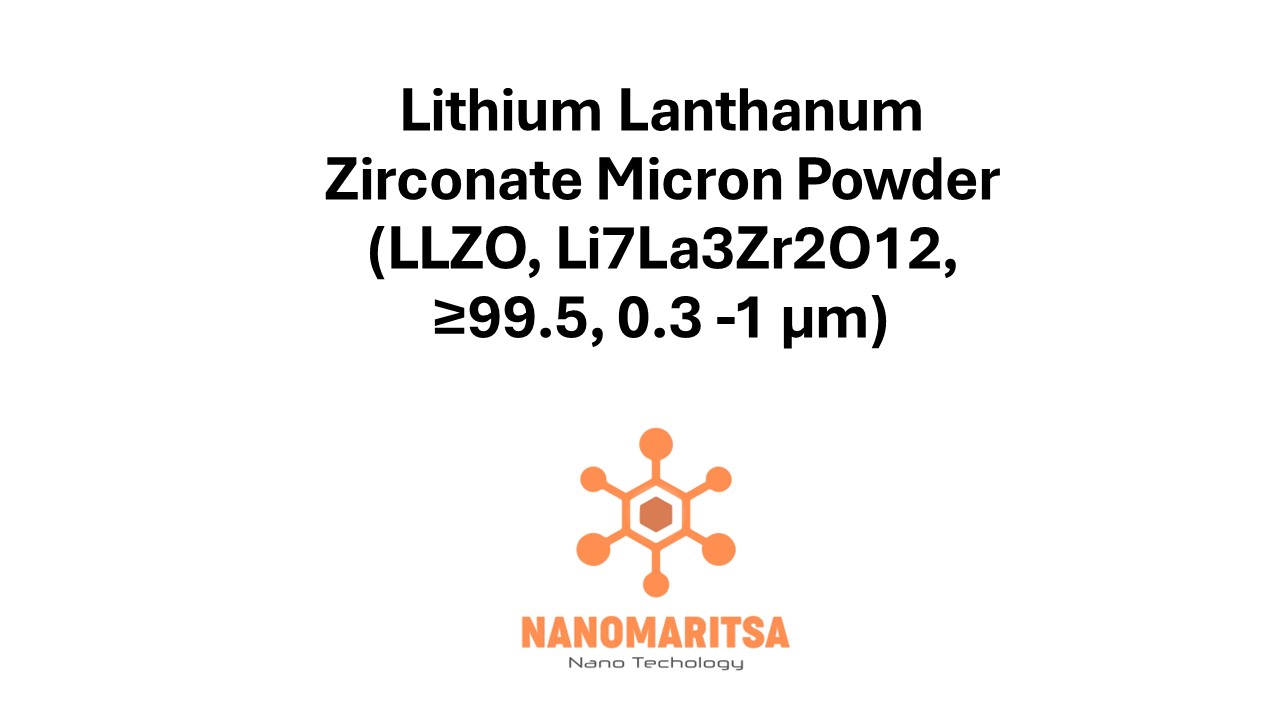Lithium Lanthanum Zirconate Micron Powder (LLZO, Li₇La₃Zr₂O₁₂, ≥99.5%, 0.3–1 µm) is a high-purity ceramic material widely recognized for its role as a solid-state electrolyte in next-generation energy storage systems. Known for its excellent ionic conductivity, thermal stability, and chemical robustness, LLZO is a cornerstone material for developing solid-state lithium-ion batteries and other advanced energy solutions. The small particle size of 0.3–1 µm ensures uniform dispersion and high reactivity, enhancing its integration into energy applications.
1. Key Properties
LLZO offers high ionic conductivity, facilitating efficient lithium-ion transport in solid-state battery architectures. Its chemical stability ensures resistance to degradation and reactions with lithium metal, critical for maintaining battery safety and longevity. The thermal stability of LLZO enables its use in high-temperature environments, essential for advanced battery designs. The material’s high purity (≥99.5%) minimizes contamination, ensuring consistent and reliable performance in sensitive applications. The ultra-fine particle size (0.3–1 µm) promotes even distribution, high reactivity, and seamless integration into solid-state systems.
2. Applications
LLZO is primarily used as a solid-state electrolyte in lithium-ion batteries, enabling safer, more efficient, and high-energy-density storage solutions. It is an essential material in the development of solid-state batteries, which offer improved safety, longer cycle life, and enhanced energy density compared to conventional liquid electrolyte systems. The material is employed in energy storage systems for grid stabilization and renewable energy applications, where durability and reliability are paramount. It supports the design of lightweight, compact batteries for portable electronics and wearables, enhancing energy efficiency and capacity. LLZO is also central to research and development for next-generation battery chemistries and advanced electrochemical systems.
3. Advantages
LLZO provides exceptional ionic conductivity, enhancing charge/discharge rates and overall battery performance. Its stability with lithium metal ensures reduced dendrite formation, contributing to the safety and longevity of solid-state batteries. High thermal and chemical stability make it suitable for demanding applications, including high-temperature energy storage systems. The fine particle size enables precise processing and uniform distribution, optimizing battery designs and enhancing material performance. Its versatility and compatibility with advanced energy storage systems position LLZO as a key material for cutting-edge battery technologies.
4. Recent Trends and Research
Research into solid-state lithium-ion batteries is leveraging LLZO’s properties to address challenges related to energy density, safety, and scalability. Efforts are focused on improving the interfacial contact between LLZO and electrodes to minimize resistance and enhance battery efficiency. Researchers are exploring doped LLZO variants to optimize ionic conductivity and stabilize the material’s crystal structure. Studies on cost-effective production methods aim to make LLZO more accessible for large-scale applications, such as electric vehicles and grid storage. Hybrid designs integrating LLZO with other solid electrolytes are being developed to achieve superior performance in next-generation energy storage systems.
5. Future Prospects
LLZO’s role in the electric vehicle market is set to grow as solid-state batteries become a primary focus for achieving higher energy densities and improved safety. Renewable energy integration will drive demand for LLZO in energy storage systems that stabilize power grids and support clean energy adoption. The push for smaller, more efficient energy storage solutions in consumer electronics will benefit from LLZO’s unique properties. Advances in manufacturing and recycling technologies will further support the adoption of LLZO in sustainable energy applications. LLZO’s compatibility with future battery chemistries, such as lithium-sulfur and lithium-air systems, positions it as a critical material for innovative energy storage solutions.
Lithium Lanthanum Zirconate Micron Powder (LLZO, Li₇La₃Zr₂O₁₂, ≥99.5%, 0.3–1 µm) combines high ionic conductivity, exceptional stability, and fine particle size, making it indispensable for solid-state batteries and advanced energy storage technologies. Its role in enabling safer, more efficient, and sustainable energy solutions ensures its continued importance in the advancement of energy storage systems.






